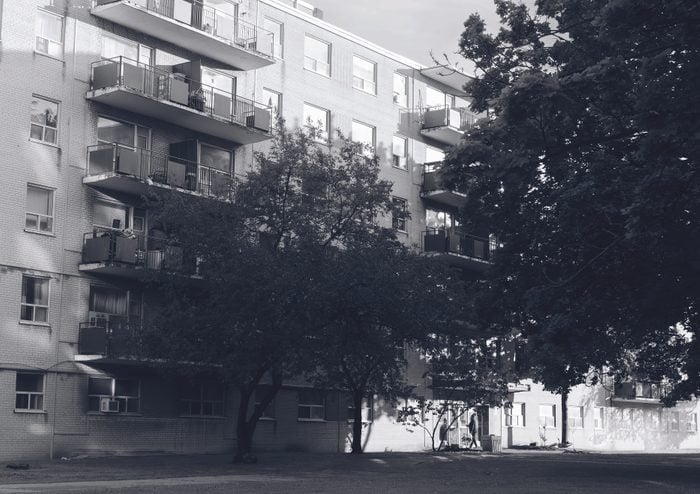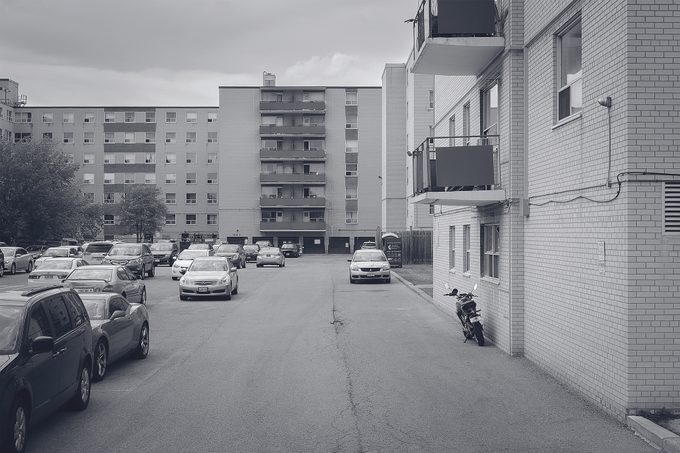This Mother Couldn’t Work During the Pandemic—Now She Faces Eviction and Owes $17,000 in Rent

Nina Hodder, like many parents living paycheque to paycheque, lost work because of the pandemic. This is the story of her fight to keep her home.
At the end of 2019, Nina Hodder felt like her life had finally become more settled. At 31 years old, she had three children, aged 13, three and six months. She’d found a two-bedroom, $1,900 a month apartment on the east side of Toronto, in the same building her parents lived in. She had steady work cleaning the production trailers on film sets for $16 an hour. Her fiancé, Glynn Broughton—who is also the father of her youngest—moved in with her, bringing along his three-year-old son from a previous relationship. Home was crowded, but Hodder was happy.
Broughton, a tool and die operator, stayed home and cared for the kids so Hodder could work. Hodder’s parents pitched in with child care, too. But money was still tight. Hodder, who made around $1,500 a month, was the main breadwinner. The family received $1,623 a month in federal support for low-income parents. That meant more than half of Hodder’s income went to rent. Although she was eligible for subsidized housing and had applied for it, there was an 11-year wait for a family of their size.
She’d only been in the apartment a month when she decided to withhold at least part of her rent because the building’s landlord had yet to install a promised radiator in her living room. Where it should have been a scalding metal pipe stuck out of the floor. Hodder was terrified her kids would get burned and did her best to block the pipe with the living room sofa.
Hodder’s building is owned by a numbered corporation that is marketed, along with other buildings in Ontario and Quebec, using the trade name Golden Equity Properties. When I asked, the landlord’s spokesperson wouldn’t comment on maintenance issues.
In the middle of February 2020, Hodder’s landlord served her with a notice of eviction for missed rent payments. Their dispute may have been resolved one way or the other within a matter of months, but then everything changed, and not just for Hodder.
The Pandemic Comes to Canada
At the beginning of March, Hodder was at work cleaning a trailer when a news report on the radio made her realize that the “novel coronavirus” she’d been hearing about was now closing in on her and her family. As a working mother, she didn’t have much time to think about it, but then, on March 17, Ontario declared a state of emergency—and ordered its first lockdown.
Not long after that, Hodder got a call from her boss. Since all film productions in the city were shut down, they had to lay her off. Then, in April, the company pivoted to providing hospital workers with a place to quarantine after shifts in the COVID-19 wards.
Hodder didn’t feel she had a choice but to take the work. But during that first shift, as she donned an N-95 mask and pulled on rubber gloves, her anxiety began to rise. By then, everyone knew the COVID-19 virus caused dangerous respiratory symptoms. Hodder had had asthma since she was a kid. She used an inhaler to keep the worst of it at bay, but she didn’t know if she would survive an infection. Was she at high risk, she wondered?
One day, while Hodder was at work, Broughton heard a knock at the door. He opened it to find the building’s superintendent, who was holding his phone in front of him. The property manager shouted through the speaker “You’re NSF! You’re NSF!”—shorthand for “non-sufficient funds,” meaning that Hodder’s bank account didn’t have enough money in it to cover her rent. When Hodder returned home and heard what happened, she felt humiliated. The exchange must have been heard by all her neighbours in the shared hallway.
Each morning she commuted to work, she worried about contracting COVID-19 and transmitting it to the kids—not much was yet known about how the virus could affect children. If her parents needed any help, she was the one they’d call on, and they were at high risk, too, due to their age.
She called her boss and quit.
A Crisis Moment for Canadians Living in Poverty
One million Canadians lost their job at the beginning of the pandemic, and large numbers had to leave their employment to care for family members. Immediately, it became clear that younger, lower-earning women were disproportionately affected, as they’re overrepresented in the kind of service jobs affected by COVID—a list that includes cleaners.
It was a crisis moment for the 10 per cent of Canadians living in poverty, who already struggled to meet increasingly unaffordable rent. That fact wasn’t lost on elected officials. As the economy shuddered to a halt, many provinces and territories enacted eviction bans to save tenants from being kicked out of their homes.
Ontario placed a moratorium on evictions as of March 19, 2020. Hodder felt relief—especially since leaving her job meant she wasn’t able to collect the then newly offered Canadian Emergency Response Benefit. But whenever she left her building for groceries, she’d pass notices that had been posted by her landlord. Next to several that listed federal and provincial assistance programs tenants could apply for, there was one that informed them that, despite the moratorium, they were still expected to pay their rent. After all, the bulletin added, no government relief was being offered to landlords.
To Hodder, the eviction ban was her permission from the government to ignore her landlord. She’d seen Premier Doug Ford speaking about the moratorium on TV and remembered him saying, “[P]ay if you can, but if you’re down and out and just don’t have the money, food is more important to put on the table than paying rent.”
“So I thought, well, I’ll feed my family,” says Hodder.
Similar scenarios played out across the country. According to a survey conducted by the Association of Community Organizations for Reform Now—a union of anti-poverty activists—an estimated 35 per cent of Canada’s 4.6 million renter households wouldn’t be able to afford their rent come May 1, 2020. Yet only 42 per cent of them would qualify for CERB. The rest, like Hodder, faced eviction.

A Second Plague
Life remained in a stressful holding pattern for Hodder into late spring and early summer. She spent her days juggling child care, her eldest’s online schooling and helping to care for a relative in recovery from a major surgery. She longed for the days when it was safe to go to work, which used to be her only moments of relative calm and solitude from all the people who needed her. Despite the upheaval, she decided to do the online coursework to complete her GED, with the hopes of starting a new career as a personal support worker.
Then, as if one plague weren’t enough to deal with, Hodder’s apartment became infested with bedbugs. She can’t remember when she started seeing the first bite marks on her feet, legs and back, but it wasn’t long before they got to her kids, as well. The landlord sent in an exterminator, but Hodder says by the time that had happened, she’d thrown out her couch, bunk beds, three dressers and her toddler’s beloved Thomas the Tank Engine bed. “I had no other choice,” she says. “The building didn’t act on it quick enough.”
Even after her apartment was treated, the bugs returned. Hodder believes this is because none of the surrounding units had been treated, which would be the only way to stop the bugs from continuing to migrate to hers. Although a spokesperson for Hodder’s landlord confirmed they do not always spray neighbouring units, he told me regular treatments are scheduled for all apartments in the building. (As for Hodder’s bedbug complaints specifically, the spokesperson did not wish to comment.)
Hodder scraped together enough money to buy replacement furniture. In all, she estimates she spent $2,500, including the price of a hotel stay during the first extermination. After several complaints to the building manager, the landlord agreed to book the pest removal company a second time. According to Hodder, it was several months before they paid a visit.
Meanwhile, Hodder says the amount she owed in rent had grown to around $8,000. What little money she did have from government supports was quickly eaten up by groceries and her phone and Internet bills. Some more financial help did come, though. Hodder used her tax return to pay half the debt, and her parents covered the rest.
The sense of relief from a clean slate didn’t last long. A month later, she couldn’t pay rent again.
The Pandemic Eviction Moratorium is Lifted
In August 2020, as Ontario’s new COVID-19 cases decreased and the province began relaxing emergency restrictions, the province lifted its eviction moratorium. The process of evicting Hodder that had begun back in February during the radiator dispute would now move forward to the Landlord Tenant Board. In the first stage of that process, tenant and landlord go before the LTB for a case management hearing, where they attempt to come to a settlement that works for both. If they can’t agree, an eviction hearing is scheduled, which is when both parties can state their case to an adjudicator. Fortunately for Hodder, the pandemic had caused a significant backlog of about 7,000 cases in Ontario alone. Her case management hearing was scheduled for November.
Meanwhile, Hodder had grown furious with what she saw as the landlord’s neglect of basic maintenance. She and her family could barely sleep because of the stress caused by the bedbugs. There was also black mould in the bathroom, and the pipes under the kitchen sink leaked. And all this was happening during a pandemic, when she and her family were stuck at home. For their part, her landlord’s spokesperson said that, during the pandemic, many contractors were shut down, which caused delays. But Hodder expected better. Even if she could’ve paid some small portion of her rent each month, she put her foot down. “I didn’t care what I owed them. They owed me more,” she says. She hoped continuing to withhold rent would prompt her landlord to properly rid her unit of bedbugs and take care of all the other issues.
The law required Hodder to pay her rent, of course, but she wasn’t alone in refusing to. In Ontario, housing activists coordinated their efforts to coach tenants on their right to an eviction hearing and how to fight an eviction. Similar movements sprang up across the country during the pandemic. In one notable instance in Toronto, in a high-rise not far from where Hodder lives, a group of tenants calling themselves the East York 50 began sharing information and standing together to shout at sheriffs coming to execute evictions. That union, which grew to hundreds of tenants, even found collective representation. After they did that, and as of June 2021, not one had been evicted.
“In cities like Toronto, all legislation, process procedures, the court systems, all are in favour of the corporate landlords,” says Sam Nithiananthan, a member of People’s Defence Toronto, an activist group that fights for tenants’ rights. The job and income loss that resulted from the pandemic, he says, allowed tenants time to sit still and wonder, “Why am I paying this much money for a shoebox that’s filled with pests?”
The First Hearing
When Hodder’s LTB case management hearing arrived on November 12, it didn’t last long. To speed up negotiations, the Ontario government had passed a new bill that allowed landlords and tenants to make repayment arrangements without any assistance from LTB officials. At Hodder’s hearing, the adjudicator asked if she would want to try this, and she agreed to give it a go.
What happened on a call between Hodder and her landlord, which took place the same day, depends on whom you ask. Hodder says she proposed a repayment plan for all rent owed in exchange for the repairs, as well as reimbursement for the furniture and hotel costs related to the bedbugs. A spokesperson for her landlord says that while Hodder did offer to use funds from the Toronto Rent Bank—a city-run loan program for people behind on rent—to pay half of what she owed, she didn’t commit to a repayment plan. What they both agree on is that it was a stalemate, which meant they’d move on to an eviction hearing, set for May 2021.
By the end of November, more than eight months into the pandemic, Hodder was distraught and unsure what to do next. She’d long struggled with bipolar disorder (she’d been diagnosed at age 16), a condition that can cause extreme shifts in mood. At times, the disorder created problems at work and in her relationships. Normally, she got through it, but the stress of the pandemic was too much. “I asked Glynn to watch the kids so I could go get help, because I was hitting rock bottom,” she says. “I was about to end my life.”
She waited in a hospital emergency room until she saw a psychiatrist, then returned home at one in the morning with a prescription that would ease her symptoms.
Living At the Edge of Eviction
In the six months that followed her first LTB hearing, Hodder completed her GED and enrolled in online courses to become a personal support worker. She had hope for her future, but she now owed around $17,000 in rent. The experience with the bedbugs and the maintenance issues convinced her it was time to move. Unfortunately, no landlord she approached seemed willing to accept her family as tenants. In one instance, she says, she was told her family was too big for the unit she could afford.
This past May 5, the date of Hodder’s second online hearing at the LTB, it seemed likely that her eviction would be finalized. By that point, Hodder wanted to leave Toronto altogether—rent was too expensive, and the COVID lockdowns were more restrictive in the city. But with her credit history in tatters, she’d likely be forced to move her entire family into her parents’ three-bedroom apartment.
In the end, though, Hodder and a representative from her building’s landlord agreed to accept one last option for working it out, which was to negotiate with the help of an LTB mediator. In a private room of the online hearing, the two came to a resolution. The landlord promised to complete repairs on her apartment and deduct $2,688 from the amount she owed. And Hodder agreed to begin paying her rent again each month, with an $846 monthly top-up until the debt was gone.
To keep her apartment, Hodder would need to find a job at which she could earn enough to pay the additional amount each month. When she returned from mediation to speak to the LTB’s main hearing room, the adjudicator read out the agreement and asked Hodder if she understood Section 78 of the Residential Tenancies Act.
“Yes,” she replied. The adjudicator had to use this legal jargon, but Hodder knew what was at stake. According to Section 78, if she’s late or short on rent again, the eviction can proceed without another hearing. Although she’d still have ways to appeal the order, the odds of her winning the fight grow slimmer at each step—and 11 days after a family receives an order, sheriffs begin planning a time to remove them from their home.
Next, read up on the homelessness crisis in Toronto.






